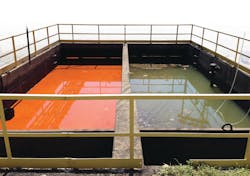Given the hundreds of lubricant connections, bearings, hydraulic seals and other moving components in the equipment and machinery found at a power generation plant, it is inevitable that some oil and grease will escape, finding its way into the process water, cooling water or cleaning water that flows throughout the facility. In order to prevent any oily water from escaping into the environment, power plants are focused on recovery of the waste oil before the water is reused, treated, filtered or discharged into a waterway or sewer system. This article will identify the sources of oil and water in common power plant applications and review common methods — and cost-saving options — for separating and removing oil from water.
Oil origin
Petroleum-based products ranging from fuel oil and hydraulic fluid to lubricating greases and oils are critical to operational success at every type of power generating plant — including coal-fired, gas-fired, hydroelectric and nuclear. Lubrication supports bearings and moving parts in equipment like pumps, conveyors, feeders, scrubbers, cranes and turbines. Hydraulic systems are prone to leak; oil holding reservoirs can overflow; hydraulic fluid lines may break and bearings cast off grease, resulting in a consistent presence of fats, oils and grease (FOG) in a power plant’s wastewater stream.
Types of water
It takes a lot of water to keep a power plant running, and even more water to keep facilities clean, and sometimes it rains, adding additional water to consider. There are various types of water found at power generation facilities and it may combine with oil at some point during its journey.
Process water
At hydroelectric plants, high-pressure process water drives the power-producing turbines, but it can come into contact with essential lubrication.
Cooling water
Power plants use water from cooling towers to cool and condense the steam exiting a turbine. As the water circulates, it can pick up trace amounts of hydraulic oil and lubrication.
Condensate
Condensation is created when the steam used to drive turbines is cooled. The condensate can pick up oil from the lubricated parts of turbines and other equipment. Condensate is sent back to the boiler where it is turned back into steam, and the process starts over.
Washdown water
When equipment and facility floors are washed down, some of this oil and wash water combine. Commonly, wash water flows to a collection sump where it can be treated and filtered before reuse or discharge.
Rain water
During rain events, water can come into contact with oily surfaces around the plant. Many facilities collect the runoff water in sumps or pits to be treated properly before it drains away to the sewer system.
Typically, water flows to outflow collection points of cooling systems and wastewater treatment facilities, or to drainage sumps and pits deep within the facility, bringing with it any oils or grease it may come into contact with. At some of these points, there is an opportunity to recover the oil before the water is reused, treated, filtered or discharged into a waterway or sewer system. The challenge then becomes finding the most efficient, cost-effective solution to address both of the two key steps to any waste oil problem: separation of the oil from water and removal of the oil.
The first step to successfully removing oil from water in any application is to achieve sufficient separation of the two elements. If oil and water remain mixed or emulsified, the task of removing oil becomes nearly impossible. So, how can oil separate and float freely on the surface of water? Most commonly, the answer is oil-water separators.
Oil-water separators
Depending on the flow rate of the oily waste stream, the oil droplet size and surface area, existing sumps, pits or ponds at power generation facilities can be used to accommodate separation of oil from water. They must be large enough, provide calm conditions and enough time must be available for the separation process to take place naturally. In these applications, oil can be removed directly from the surface of the water with an oil skimmer. In other applications, due to the sheer volume of water used, sumps alone do not have the space or capacity to hold such large volumes of oily water long enough to accommodate sufficient separation.
This is where oil-water separators become relevant. Using a smaller footprint, oil-water separators use a variety of methods — usually baffles and coalescing media — to increase the surface area that comes into contact with the oily water. The increased contact facilitates and maximizes the number of small oil droplets that will agglomerate and rise to the surface of the water. This forms a floating layer of waste oil, ready for removal; however, most traditional oil-water separators do not provide an active solution for removal of the oil.
Step 2: Removing oil from water
Some separators feature passive oil removal by using slotted pipes or overflow weirs that allow surface oil to overflow and drain to a collection vessel. These methods require monitoring and manual adjustment, demanding time and labor from maintenance personnel. If left unmonitored, a weir or slotted pipe set too high can cause a layer of oil to build up on the surface, causing a host of other maintenance and performance problems, including:
Any sudden or heavy inflow of water (for example, from a storm) can exceed the separator’s capacity, washing out the oil layer and causing it to mix with the clean effluent.
The oil layer takes up space in the separation chamber, reducing the overall area and affecting the functionality and efficiency of the separation process.
A build up of oil prevents oxygen from reaching the water’s surface, resulting in formation and growth of anaerobic bacteria that can cause skin irritation, clog coalescing media and emit foul odors.
Dirt and debris collect rapidly on the oil layer, combining with it to form a heavy sludge. The sludge can sink, effecting the performance of coalescing media and disrupting the operation of the separator.
Conversely, if set too low, a lot of water escapes with the oil, simply transporting the oily water issue to another collection vessel.
Quite commonly, oil-water separators at power generating plants do a good job of separating, but when it comes to removal, proper maintenance is essential to prevent accumulation of waste oil on the surface. So, what is the best solution for removal of oil once it is separated? Let’s review some of the methods used.
Post-separation removal
When oil is floating on the surface of wastewater, process water or coolant — whether in an oil-water separator, sump, pit or pond — it needs to be removed. Otherwise, oil can move with the water to treatment processes, sewers or waterway. In the filtration process, oil left in water can coat sensors and blind filters, resulting in frequent and costly replacement. During chemical treatment, oil content may decrease the effectiveness or require increased chemical usage. When discharging wastewater to the municipality or local water authority, oily water may lead to fines and costly testing. To prevent these issues and costs, there are various methods used to remove oil from water.
Sorbents
Sorbent materials either absorb oil, or oil adheres to its surface. They are most effective when used to recover small amounts of oil, like spills on the floor, and are not as practical for many other applications, like recovering larger volumes of oil from sumps or separators. Sorbents do not offer automatic or continuous oil removal and require the attention of maintenance personnel. Some sorbent materials are reusable, but when it comes to proper disposal, they must to be sent to a landfill or incinerated.
Vacuum trucks
Some facilities employ the services of vacuum trucks to periodically remove waste oil from collection points at the plant. If the waste oil has been thoroughly separated and the trucks take mostly just oil, these services can be efficient. However, vacuum trucks are commonly used to pump oil layers directly off the water, and that can result in the intake of significant amounts of water, and when paying by volume, power plants end up paying a lot to haul away water. Adding to the expense is the number of visits required by vacuum trucks. The ideal solution would be to continuously remove oil and prevent oil buildup on the water, but vacuum trucks only resolve this issue during their occasional visits.
Oil skimmers
Automatic oil skimmers are an ideal option for oil removal. They complement or replace other methods, are efficient and reduce costs. Available in a wide range of types and sizes, skimmers offer versatility, operate unattended, cut labor requirements and remove only oil. Skimmers can be used to remove oil from any water-holding area including separators, sumps, pits, ponds, lagoons and cooling towers. With unattended, automatic operation, oil skimmers remove oil with efficiency that exceeds other methods, yet with far lower labor costs. After using skimmers to remove oil, plants can still opt to use vacuum trucks to haul the oil at lower costs since they are not taking any water with it.
Choosing an oil skimmer
While a wide range of oil skimming equipment is available, the maintenance needs of a power plant require skimmers with these essential characteristics and capabilities, including:
Vertical lift
The oil skimmer must be able to reach the oily water. Within the structure of a plant, the drainage pits or sumps may be located up to 100 feet deep. For purposes of installation, maintenance and inspection, the skimming equipment should be accessible to maintenance personnel while still able to reach down to the water and lift the oil back up to be collected.
Fluctuating water levels
The oil skimmer should be able to adjust to fluctuating water levels and maintain operation.
Floating debris
Skimmers vary in their ability to remove oil from water where floating debris is present — a common circumstance in power plant drainage systems. Skimmers that operate in a fixed position, have manually adjusted inlets or follow a fixed path can be disrupted when debris collects around them and limits access to floating oil. An oil skimmer with a free-floating collector tube eliminates this potential inefficiency as it floats freely on the surface, snaking around any debris.
Conclusion
If power plants face challenges with oily water management, their existing solutions for separation and removal of oil should be reviewed and evaluated for both efficiency and cost. Some questions to consider include:
- Are there any current or past issues with oily water being discharged from the facility?
- Is there a lack of resources preventing the timely removal of oil accumulation in sumps, pits or separators?
- Is the cost for vacuum waste disposal high due to large volumes of water being taken with the oil?
- Is the cost for water treatment high because oil was not properly removed prior to water reaching filtration or chemical treatment?
Whether facilities skim oil directly from an existing sump or separator or install equipment like a Separate and Skim (SAS) Tank that combines solutions for both separation and removal, it is important that the wastewater at power plants is kept free from the waste oil that has the potential to lead to costly issues. In addition to the cost savings realized by efficient, continuous oil recovery, there may be opportunities to generate new revenue by selling the recovered oil to recyclers.




